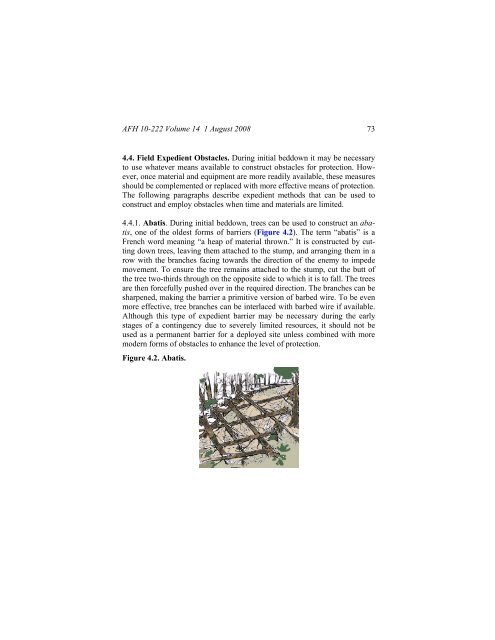Civil engineer guide to fighting positions, shelters, obstacles
Civil engineer guide to fighting positions, shelters, obstacles
Civil engineer guide to fighting positions, shelters, obstacles
Create successful ePaper yourself
Turn your PDF publications into a flip-book with our unique Google optimized e-Paper software.
AFH 10-222 Volume 14 1 August 2008 73<br />
4.4. Field Expedient Obstacles. During initial beddown it may be necessary<br />
<strong>to</strong> use whatever means available <strong>to</strong> construct <strong>obstacles</strong> for protection. However,<br />
once material and equipment are more readily available, these measures<br />
should be complemented or replaced with more effective means of protection.<br />
The following paragraphs describe expedient methods that can be used <strong>to</strong><br />
construct and employ <strong>obstacles</strong> when time and materials are limited.<br />
4.4.1. Abatis. During initial beddown, trees can be used <strong>to</strong> construct an abatis,<br />
one of the oldest forms of barriers (Figure 4.2). The term “abatis” is a<br />
French word meaning “a heap of material thrown.” It is constructed by cutting<br />
down trees, leaving them attached <strong>to</strong> the stump, and arranging them in a<br />
row with the branches facing <strong>to</strong>wards the direction of the enemy <strong>to</strong> impede<br />
movement. To ensure the tree remains attached <strong>to</strong> the stump, cut the butt of<br />
the tree two-thirds through on the opposite side <strong>to</strong> which it is <strong>to</strong> fall. The trees<br />
are then forcefully pushed over in the required direction. The branches can be<br />
sharpened, making the barrier a primitive version of barbed wire. To be even<br />
more effective, tree branches can be interlaced with barbed wire if available.<br />
Although this type of expedient barrier may be necessary during the early<br />
stages of a contingency due <strong>to</strong> severely limited resources, it should not be<br />
used as a permanent barrier for a deployed site unless combined with more<br />
modern forms of <strong>obstacles</strong> <strong>to</strong> enhance the level of protection.<br />
Figure 4.2. Abatis.
















